The Sunshine State is home to a wide range of fascinating reptiles, and its turtle population is especially diverse and stunning! There are around 30 different types of turtles in Florida, but we’ll cover 10 of the most unique and interesting ones you should know about below.

From tiny softshell turtles to massive 500-pound sea turtles and fearsome snapping turtles, let’s dive in and take a closer look!
1. Florida Softshell Turtle (Apalone ferox)
The Florida softshell turtle has many unique traits, the most unusual being its long, snorkel-like snout and smooth, cartilaginous shell. True to its name, its dark brown shell has no distinct ridges or scutes, making it flat and soft to the touch. The Florida softshell is actually one of the largest softshell turtle species, ranging from 6 inches to 25+ inches from snout to tail tip!
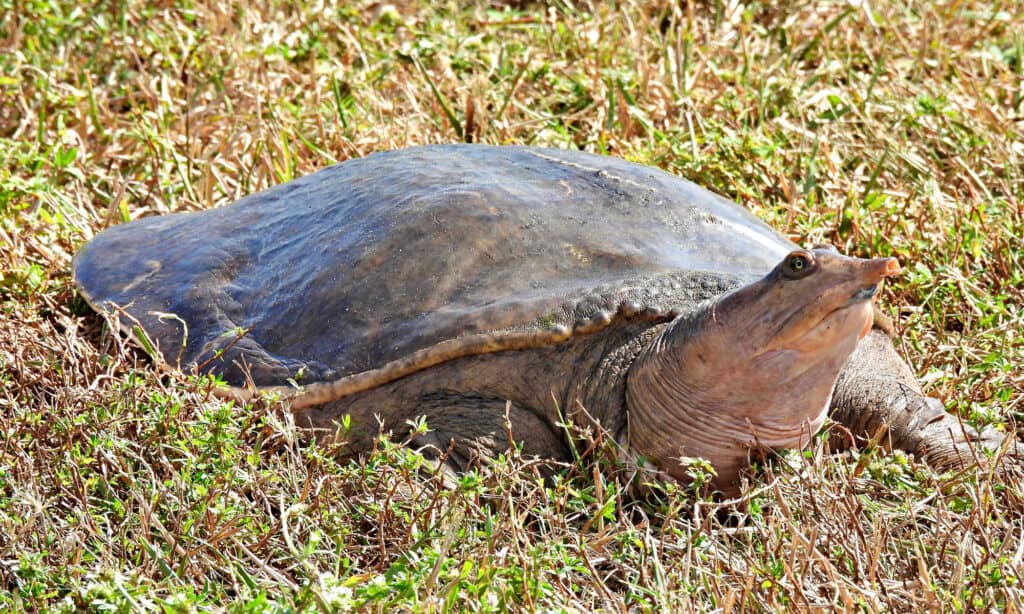
The Florida softshell turtle can be easily identified by its long, narrow snorkel-like snout and flat, smooth shell.
©iStock.com/passion4nature
This strange turtle is almost fully aquatic, preferring muddy, shallow bodies of water like ponds and slow-moving streams. Its thin snout helps it breathe while staying partially submerged in search of prey (or while hiding from predators). Its dark brownish-grey body color helps it camouflage itself in the muddy substrate and leaf litter. Meanwhile, the turtle’s webbed feet and clawed toes make it well-suited to a mostly aquatic lifestyle.
This species’ native range extends throughout most of Florida as well as parts of southern Georgia. It’s a pretty opportunistic omnivore, usually feeding on small aquatic insects, fishes, and amphibians.
2. Loggerhead Sea Turtle (Caretta caretta)
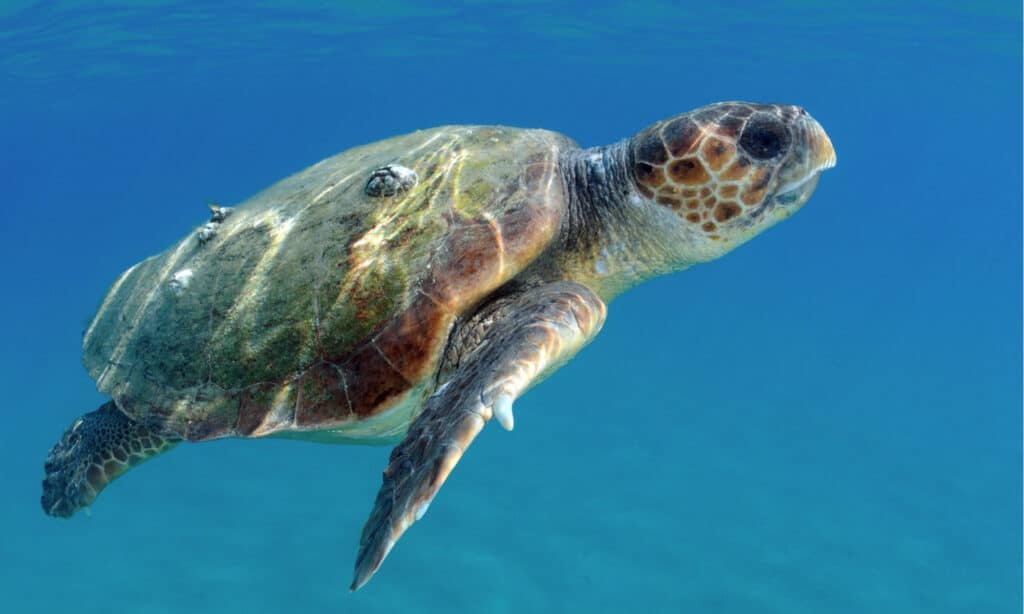
Loggerhead sea turtles can weigh up to 1,000 pounds.
©Matteo photos/Shutterstock.com
The first thing you’re likely to notice about the loggerhead sea turtle is that it’s absolutely massive! Its carapace alone can range from 20 to 35 inches long, and it commonly weighs well over 500 pounds. Some individuals have even been recorded topping 1,000 pounds!
Because it is almost entirely aquatic, the loggerhead sea turtle has long, strong flippers instead of clawed feet. Its skin is usually light beige in color with darker brown spots along the head, legs, and flippers. The shell is brown to reddish-brown in color with large, wide scutes. Males generally have thicker tails and shorter plastrons (belly shells) than females.
Their jaws and beaks are strong and sharp, giving them lots of options when it comes to prey. They mainly eat small aquatic invertebrates, though.
This species’ geographic range extends throughout much of the warmer regions of the Atlantic, Indian, and Pacific Oceans. It also can be found in the Mediterranean Sea. Most commonly, it resides in fairly shallow estuaries. However, they can dive much deeper when in search of food and are extremely agile swimmers.
Amazingly, this massive reptile can live for more than 65 years! However, the species is currently endangered due to human interference and increasing coastal land development.
3. Common Snapping Turtle (Chelydra serpentina)
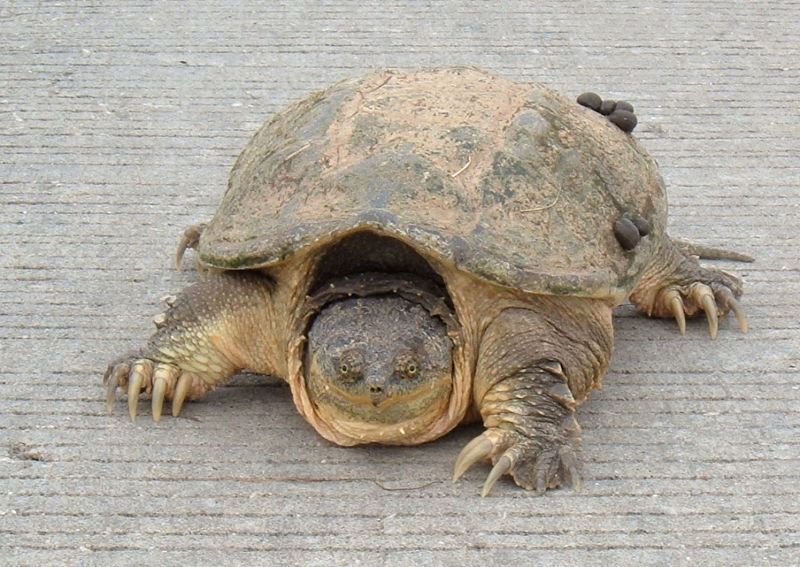
The common snapping turtle’s long claws and sharp beak make it a powerful predator.
The common snapping turtle is named such because it is the most widespread species of snapping turtle in the United States! This hardy turtle’s geographic range covers much of the Midwestern and Eastern United States. It can be found throughout Florida, but it fares best in Central and Northern Florida, particularly near the panhandle region.
In addition to being the most widespread snapping turtle species, it’s also one of the largest and heaviest freshwater turtles in the world. They typically weigh around 10 to 30 pounds, but it isn’t uncommon for them to exceed 40 pounds as adults! The species’ lifespan is also impressive, estimated to be more than 100 years.
The common snapping turtle is easily identified by its bulky build, craggy, textured carapace, and sharp, prominent beak. The carapace scutes are raised and pronounced, giving the shell its uneven, mountainous look. Males are typically larger and heavier than females.
As an ambush predator and omnivore, the common snapping turtle will munch on about anything it can get into its massive mouth. It cleverly camouflages itself just under the muddy water’s surface, where it strikes any fish, amphibians, rodents, lizards, insects, or even birds that happen to cross its path.
Though they aren’t particularly aggressive, all snapping turtle species have an extremely painful bite. If you encounter one, admire it from a safe distance!
4. Florida Mud Turtle (Kinosternon steindachneri)

The Florida mud turtle was once a subspecies of the eastern mud turtle. Today, it is its own distinct species.
©fivespots/Shutterstock.com
Florida seems to have a lot of turtles named after itself, which will become increasingly more apparent as this article continues. The Florida mud turtle, native to much of Central and South Florida, is a key example.
Originally, the Florida mud turtle was a subspecies of the eastern mud turtle, Kinosternon subrubrum. When researchers examined this particular turtle more closely in 2013, however, they determined it was unique enough to be its own distinct species. Its taxonomic name is a nod to Austrian herpetologist Franz Steindacher.
At a glance, the Florida mud turtle looks like a typical small, semi-aquatic mud or musk turtle. Small in size, it typically measures a mere 3 to 5 inches in length. Its long, rounded dark brown shell has an orange-ish brown underside. Its webbed feet and clawed toes help it navigate shallow, muddy bodies of water like ponds and marshes.
5. Leatherback Sea Turtle (Dermochelys coriacea)
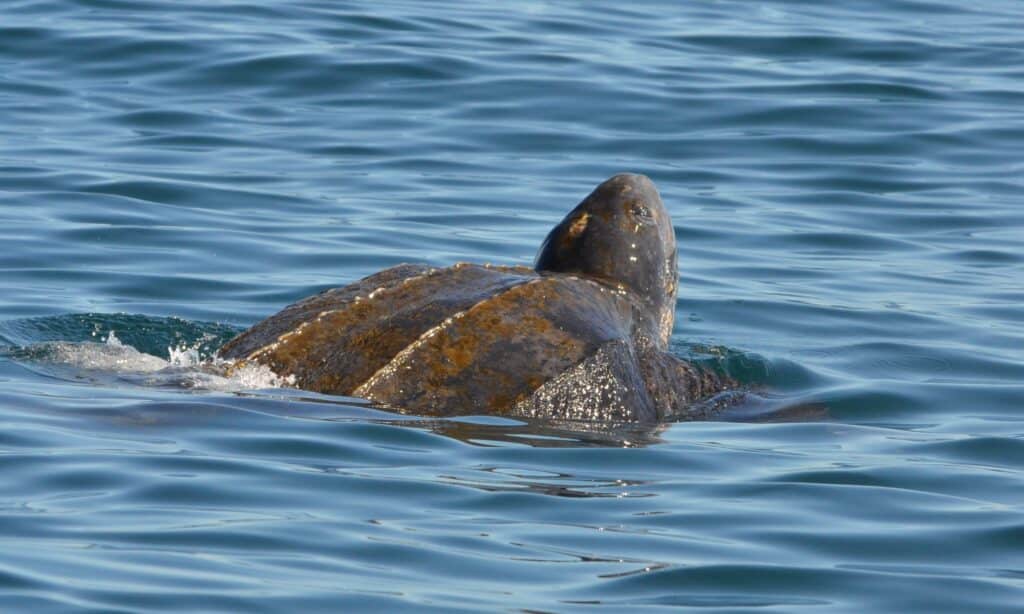
Leatherback sea turtles are the largest non-crocodilian reptiles on the planet!
©iStock.com/jtstewartphoto
Of course, this list wouldn’t quite be complete without the incredible leatherback sea turtle. As the largest of all turtle species in the world (and the largest non-crocodilian reptile!), it commonly reaches well over 700 pounds and averages 6 to 7 feet in length. Some especially large individuals can even reach 1,500 pounds!
Aside from its massive size, the leatherback’s general appearance is also quite striking. Its skin and shell are dark grey to black, with small, irregular white and beige splotches throughout. Its carapace has 7 long, parallel ridges extending down its length. Like most other sea turtles, it has long, strong, flat flippers instead of clawed toes.
As a sea turtle, the leatherback is essentially entirely aquatic, only surfacing briefly to breathe and lay eggs. It can swim at speeds exceeding 20 miles per hour and can dive as deep as 4,000 feet. What’s more, leatherback sea turtles can hold their breath for over 30 minutes at a time. Though they have plenty of options for food, they mainly feed on soft, gelatinous invertebrates like jellyfish.
The leatherback’s geographic range is very wide, extending throughout much of the Atlantic and Pacific Oceans. Sadly, this range is becoming smaller, as the species has been critically endangered since the 1970s. This is primarily due to coastal land development, pollution, and human activity in general.
6. Florida Chicken Turtle (Deirochelys reticularia chrysea)

The Florida chicken turtle has a bright red plastron to differentiate it from other subspecies.
©J. Norman Reid/Shutterstock.com
Another one of Florida’s titular turtles is the bizarrely named Florida chicken turtle. This common name actually is a dual reference to the turtle’s long, bird-like neck and how its meat is said to taste similar to chicken.
This particular turtle is actually one of three total subspecies of the chicken turtle. The Florida variety is the most colorful of the bunch! It has a bright reddish-orange plastron to differentiate it from other subspecies.
On average, it measures around 6 to 10 inches long and has webbed, clawed feet typical of most semiaquatic turtles. Females are typically larger than males. Its carapace is dark brown with a thin, light yellowish net pattern. Its skin is typically greenish-brown with thin, yellow striping.
Also, like most other semiaquatic turtle species, the Florida chicken turtle prefers shallow, muddy bodies of water like marshes and slow-moving streams. It is quite hardy and well-adapted to moving around in the water and on land. Oddly, though, it has a fairly short lifespan compared to other similar turtle species at only around 20 to 25 years.
7. Florida Box Turtle (Terrapene carolina bauri)
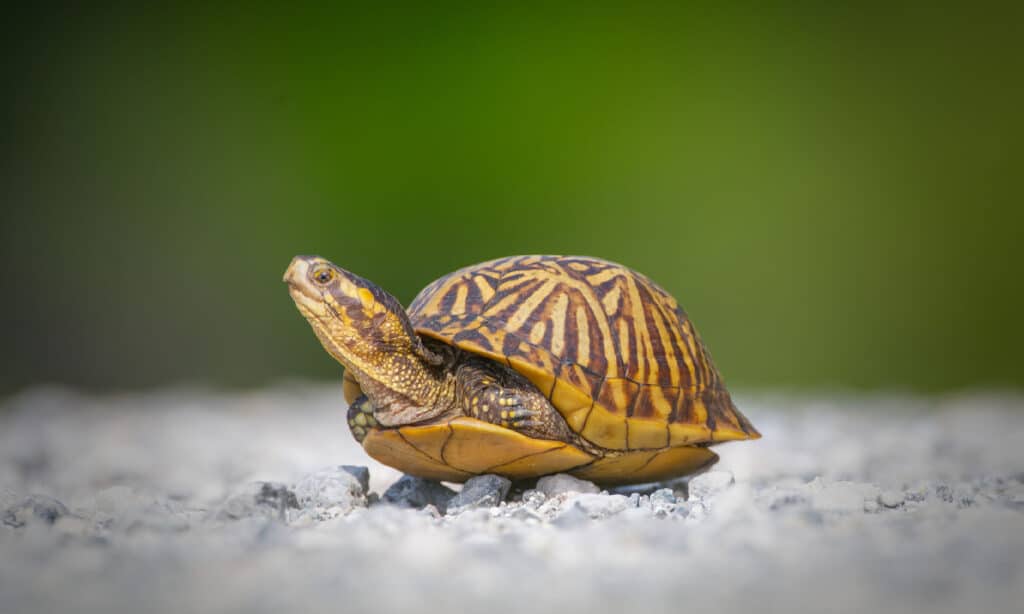
The Florida box turtle has vibrant yellow patterning atop its carapace.
©iStock.com/Dan Rieck
The Florida box turtle is similar to the aforementioned Florida chicken turtle in that it is actually a subspecies of a more widespread species. In this case, the Florida box turtle is one of six subspecies of the common box turtle. It lives the furthest south of all six subspecies and is native to most of Florida and southern Georgia.
At around 4 to 6 inches long, the Florida box turtle is pretty average in terms of its size. On average, males are slightly larger than females. Its carapace is quite tall and dome-like. The shell is mostly dark brown with bright yellow, and irregular striping throughout. The turtle’s skin is also a dark brownish-grey shade with random yellow splotches.
As a semiaquatic species, it prefers shallow, swampy habitats with lots of moist soil and leaf substrate for burrowing. It is quite hardy, with a sharp beak and webbed feet with clawed toes to allow it to easily traverse land and water when needed. The Florida box turtle is an opportunistic omnivore, feeding on a wide range of invertebrates, small fishes, and amphibians.
Notably, this subspecies’ Latin name is a nod to German herpetologist Georg Baur.
8. Alligator Snapping Turtle (Macrochelys temminckii)
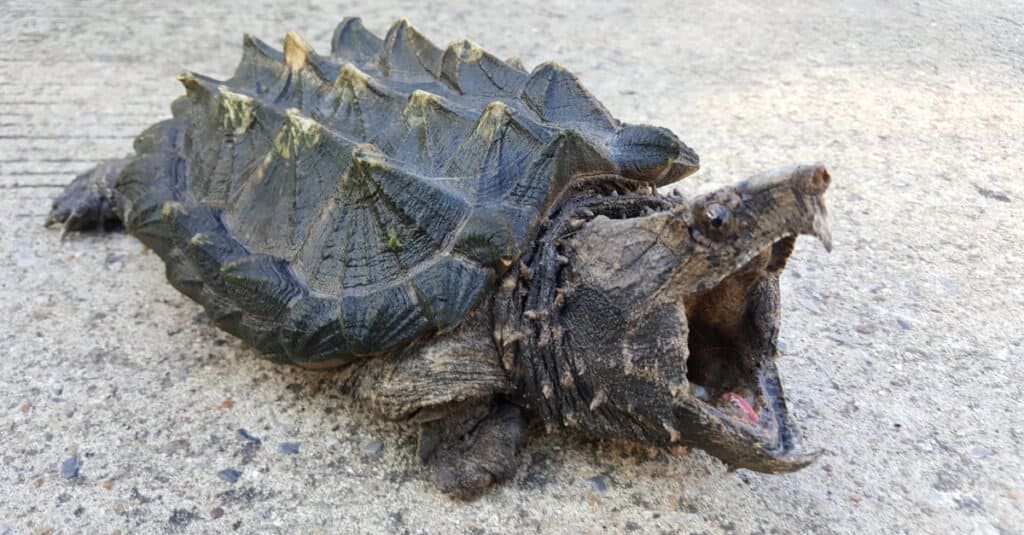
The
alligator
snapping turtle’s beak is needle-sharp, and its bite is incredibly powerful.
©Sista Vongjintanaruks/Shutterstock.com
The alligator snapping turtle is somehow even more fierce and edgy-looking than its snapping turtle relatives. This is mainly thanks to its extremely pointed, craggy, rough-textured carapace, massive, bulky head, and incredibly sharp, powerful beak. While the common snapping turtle we covered earlier is more widespread, this species is mostly limited to Florida’s panhandle region.
As one of the largest freshwater turtles in the world, the alligator snapping turtle can reach well over 150 pounds! It has quite significant variations in size, ranging from as little as 30 pounds to 170+ pounds. Individuals can measure up to 29 inches long, though 20 to 25 inches is a more typical range.
Although it appears sluggish, it is actually surprisingly fast in the water and on land as an ambush predator. It is mostly dark brown to olive green in color with yellow patterning around the head and eyes.
The alligator snapping turtle is a fierce predator, using its worm-like tongue and cavernous mouth to lure in unsuspecting fish and amphibians. It is almost entirely carnivorous and, like all snapping turtles, has a seriously painful bite.
9. Loggerhead Musk Turtle (Sternotherus minor)
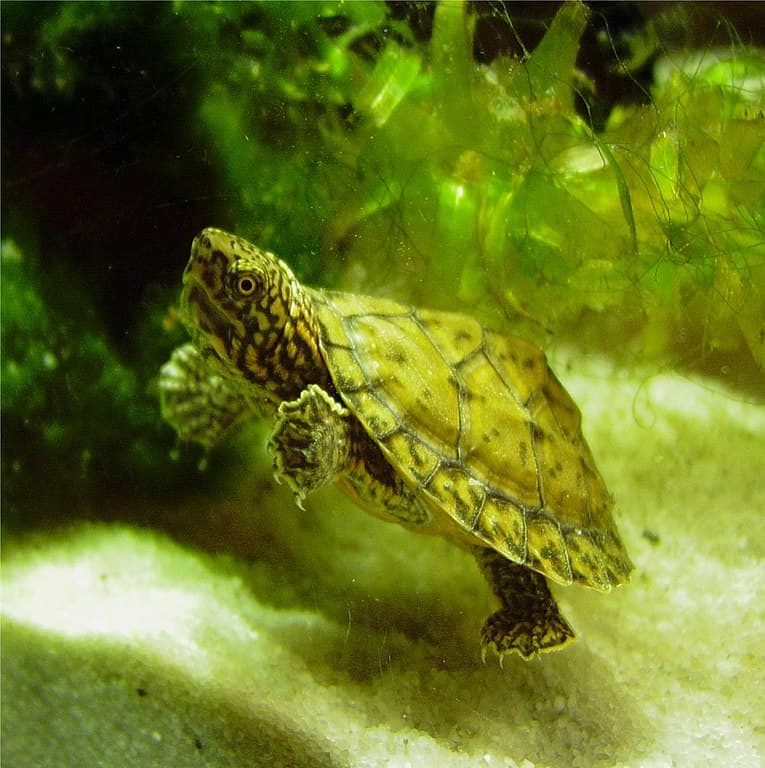
The loggerhead musk turtle has a large, bulky head compared to its fairly small body size.
©Nicole Buchmann / CC BY-SA 3.0 – License
Not to be confused with the loggerhead sea turtle, this species is much, much smaller and not nearly as aquatic in nature. The “loggerhead” name, in this case, refers to the turtle’s wide, bulky head for its size. Native to northern and central Florida, it prefers shallow bodies of water like ponds and slow-moving streams.
The loggerhead musk turtle’s large, bulky head makes it easy to tell apart from most other musk turtles. It averages around 3 to 5 inches in length when fully grown. Its skin ranges from light brown to tan in color, with small dark brown splotches throughout the head and body. The carapace is dark brown and somewhat flattened.
As a semiaquatic species, this turtle has webbed feet with claws at the end of each toe. It mainly feeds on small, aquatic inverts like clams and snails.
10. Florida Red-Bellied Cooter Turtle (Pseudemys nelsoni)
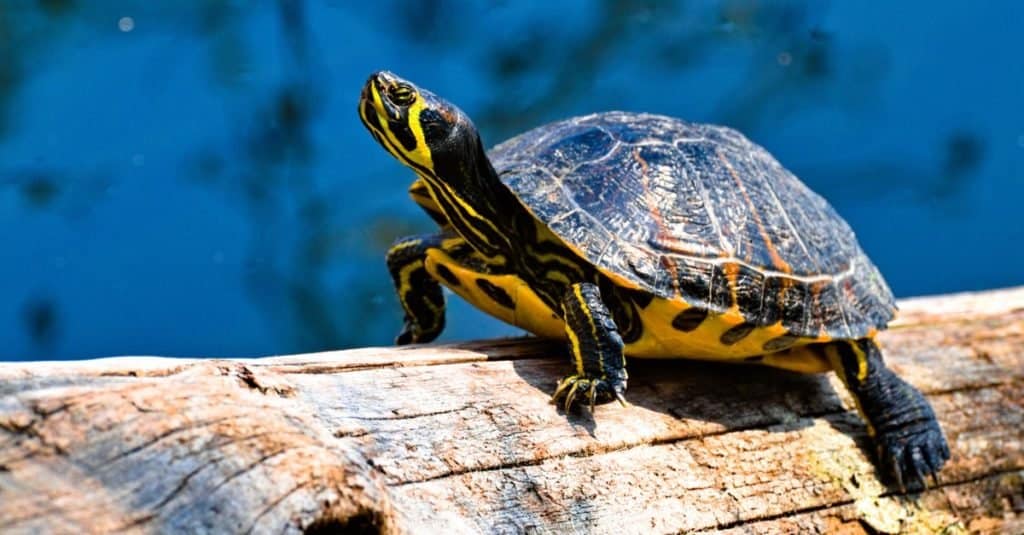
The Florida red-bellied cooter’s plastron can range in color from deep yellow to vibrant red.
©Marco Fine/Shutterstock.com
True to its name, this turtle is native to most of Florida and southern Georgia and has a bright reddish-orange belly. The rest of its shell is dark brown with a reddish trim where the carapace (top portion) meets the plastron (bottom shell). It averages around 8 to 15 inches long, with females usually being slightly larger than males.
In addition to its bright red belly, the Florida red-bellied cooter turtle is also visually stunning thanks to its thin, pale yellow striping on its greyish-brown skin. Its webbed feet and clawed toes help it navigate its semiaquatic, swampy habitat.
Interestingly, although it is a freshwater species, it is quite hardy and can tolerate brackish water well. Another unique trait is its herbivorous diet; while other similar turtles eat mainly aquatic invertebrates, Florida red-bellied cooter mostly eats aquatic plants like duckweed and algae. It can thrive in various aquatic habitats and spends a lot of time basking in the sun on partially submerged logs and rocks.
Summary of 10 Types of Turtles in Florida
Here is a list of ten types of turtles that can be found in the Sunshine State.
| Rank | Turtle |
|---|---|
| 1 | Florida Softshell Turtle |
| 2 | Loggerhead Sea Turtle |
| 3 | Common Snapping Turtle |
| 4 | Florida Mud Turtle |
| 5 | Leatherback Sea Turtle |
| 6 | Florida Chicken Turtle |
| 7 | Florida Box Turtle |
| 8 | Alligator Snapping Turtle |
| 9 | Loggerhead Musk Turtle |
| 10 | Florida Red-Bellied Cooter Turtle |
Where are the Most Turtles Found in Florida?

Protected nesting sites, like this one found in Miami, can be seen on many Florida beaches.
©SpaceEconomist192, CC BY-SA 4.0 – License
With its warm weather, sunny shores, and oceanfront surrounding nearly the entire state, Florida seems to be a haven for turtles, with over 30 different species. There are more than 10 locations that you can go to where you are likely to encounter a turtle, but where are the most turtles found? At the top of the list is Melbourne Beach, a town located in the central east region of the state in Brevard County, and the oldest beach community in the county.
Every summer, at night, the turtles are known to crawl onto the beach to lay their eggs. Some of the species you may catch sight of are Loggerhead, Leatherback, and green sea turtles. As recently as 2021, there were reported to be over 50,000 nesting female turtles just at this location. There are even nighttime nature walks that you can take, hosted by numerous organizations, one of which is the Sea Turtle Preservation Society.
If you want additional beach options, that also offer nighttime turtle walks, you can check out these other options nearby:
- Canaveral National Sea Shore – located between New Smyrna Beach and Titusville in Volusia and Brevard Counties, Florida.
- Vero Beach – 34 miles south of Melbourne, on Florida’s Treasure Coast.
The photo featured at the top of this post is © Marco Fine/Shutterstock.com
Thank you for reading! Have some feedback for us? Contact the AZ Animals editorial team.






